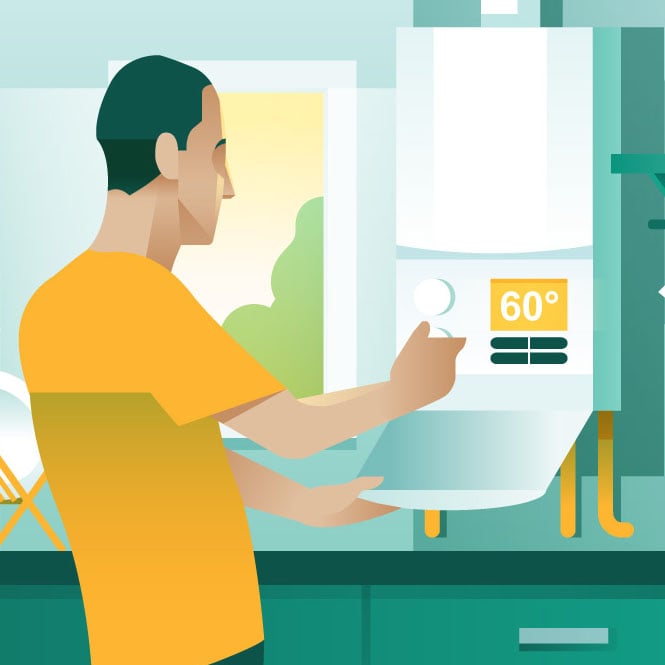Free and easy ways to reduce your household gas use

*These figures were correct when blog was published but latest figures can be found here.*
21 December 2022
With the average energy bill now costing around £2,500, we’re all looking for ways to lower our energy bills.
There is a lot of advice out there, here are some evidence-based ways you can lower energy use and reduce carbon emissions from your home.
Top five free ways to save gas at home

1. Lower the settings on thermostatic radiator valves
Average households would save £68 a year off a typical gas bill by readjusting their thermostatic radiator valves down by 1.5°C.
Thermostatic radiator valves (TRVs) are self-regulating valves fitted to radiators that control the temperature of a room by changing the flow of hot water to the radiator.
TRVs are widely misused as on/off switches. Instead, they should be set to lower temperatures in rooms such as bedrooms and non-living areas to achieve maximum savings.
How do I do this?
Each TRV has a dial, usually numbered from 1 to 5 or 6. Where TRVs are currently set to 4 or above, we recommend turning the dial to the midpoint on all radiators outside the living room (eg, 3 on a dial up to 6). Higher settings will heat the room to over 18°C, which uses up more energy.
2. Turn down the boiler flow temperature on combi boilers to 60°C
Lowering a combi boiler flow temperature from 75°C to 60°C saves a typical household £97 a year (or 8% off the gas bill), if you are willing to accept slightly lower room temperatures.
The majority of UK homes have combi boilers (gas boilers that provide heating and hot water on demand, and don’t have a separate hot water tank). Many are currently set with a flow temperature – the temperature to which the boiler heats water that gets sent to the radiators – of 70-80°C. Lowering the flow temperature to 60°C or less makes the boiler run more efficiently.
How do I do this?
Nesta has created a simple online tool to help households make this change. Go to the Money Saving Boiler Challenge tool to take this action.
3. Turn down hot water temperature on combi boilers to 42°C
Turning down hot water temperatures on a combi boiler could save a typical household £26, or 2% off their gas bill per year.
Combi boilers also allow users to control the temperature of hot water supplied to taps and showers. Reducing the hot water temperature reduces the amount of fuel needed to heat the water. Even a couple of degrees will make a difference, and will not be a noticeable change.
How do I do this?
There should be a button or dial to change the hot water temperature on the front of your combi boiler – usually indicated by a little tap icon. If you’re not sure, check your boiler manual. We do not recommend lowering this below 42°C.
4. Reduce hot water cylinder temperature to 60°C
Setting your hot water cylinder to 60°C could cut 2% off a household’s gas use, or £26 off a typical gas bill, each year.
Homes that have heating systems with a separate hot water cylinder (instead of a combi boiler) can turn down the temperature of the cylinder itself so that water is not heated unnecessarily. The temperature should not be reduced below 60°C, as legionella bacteria, that can cause Legionnaires’ disease, can survive and grow in warm water stored below 60°C.
How do I do this?
You’ll usually find the control for your hot water cylinder ⅓ of the way up the tank. Here’s some more advice for efficient hot water cylinder heating. The temperature should not be reduced below 60°C, as legionella bacteria, that can cause Legionnaires’ disease, can survive and grow in warm water stored below 60°C.
5. Turn off pre-heat settings on combi boilers
Turning off the preheat setting could save households 0.8% or £10 off a typical gas bill per year.
Some combi boilers have a pre-heat setting that enables users to get hot water straight away, rather than waiting a few seconds for the taps to run hot. In order to do this, the boiler regularly fires up to heat a small amount of hot water, even when the taps are not in use. Turning off the pre-heat setting can help save households some energy at no extra cost.
How do I do this?
The Heating Hub has created some brilliant bespoke instructions for how to turn off this setting on different boiler types: Vaillant, Ideal and Worcester.
Have a little extra budget? Here are our top low-cost solutions to save on household gas
If you are able to invest up to £300 in some smart technology, a smart thermostat could save a typical household 5.3% (or up to £64) on their gas bill a year. Newer heating controls models, such as Nest version 3, have even smarter tech that can modulate compatible boilers (essentially turning down the flame in your boiler, similar to when you turn down the gas on your hob).
Installing loft insulation is certainly worth the hassle. For a detached house without a small amount of loft insulation, a DIY job topping up the insulation from 50-100m to 300 mm can cost around £200 and save £81 off a typical yearly gas bill.
To read more about these findings, you can read the full report on Nesta’s website.
Figures correct as at December 2022. Please note the views and advice in this blog post are provided by Nesta and are not attributable to partners of the Money Saving Boiler Campaign.

This step-by-step guide walks you through changing your boiler flow temperature
It’s quick, free and easy to do. It can be changed back instantly if necessary so there’s nothing to lose by trying it.

